Lamas perform during Cham dance ritual
Xinhua
1550802297000

Tibetan Buddhist monks perform during a Cham dance ritual at the Qoide Monastery in Gonggar County of Shannan Prefecture, southwest China's Tibet Autonomous Region, Feb. 19, 2019. Dressed in colorful costumes, lamas danced to pounding drums at the Qoide Monastery during the Tibetan New Year celebrations. The Cham dance is a vibrant masked and costumed ritual performed by Tibetan Buddhist monks to exorcise evils and pray for blessings. The Qoide Monastery has a 500-year history of performing the Cham dance. The Cham dance here was listed as one of the national intangible cultural heritages in 2011. (Photos: Xinhua)

Tibetan Buddhist monks perform during a Cham dance ritual at the Qoide Monastery in Gonggar County of Shannan Prefecture, southwest China's Tibet Autonomous Region, Feb. 19, 2019. Dressed in colorful costumes, lamas danced to pounding drums at the Qoide Monastery during the Tibetan New Year celebrations. The Cham dance is a vibrant masked and costumed ritual performed by Tibetan Buddhist monks to exorcise evils and pray for blessings. The Qoide Monastery has a 500-year history of performing the Cham dance. The Cham dance here was listed as one of the national intangible cultural heritages in 2011.
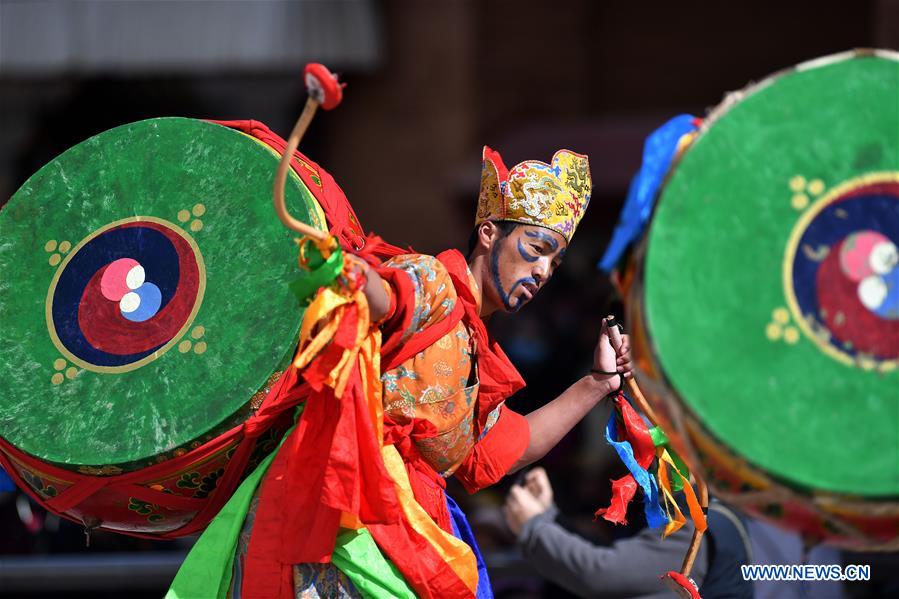
A Tibetan Buddhist monk performs during a Cham dance ritual at the Qoide Monastery in Gonggar County of Shannan Prefecture, southwest China's Tibet Autonomous Region, Feb. 19, 2019. Dressed in colorful costumes, lamas danced to pounding drums at the Qoide Monastery during the Tibetan New Year celebrations. The Cham dance is a vibrant masked and costumed ritual performed by Tibetan Buddhist monks to exorcise evils and pray for blessings. The Qoide Monastery has a 500-year history of performing the Cham dance. The Cham dance here was listed as one of the national intangible cultural heritages in 2011.
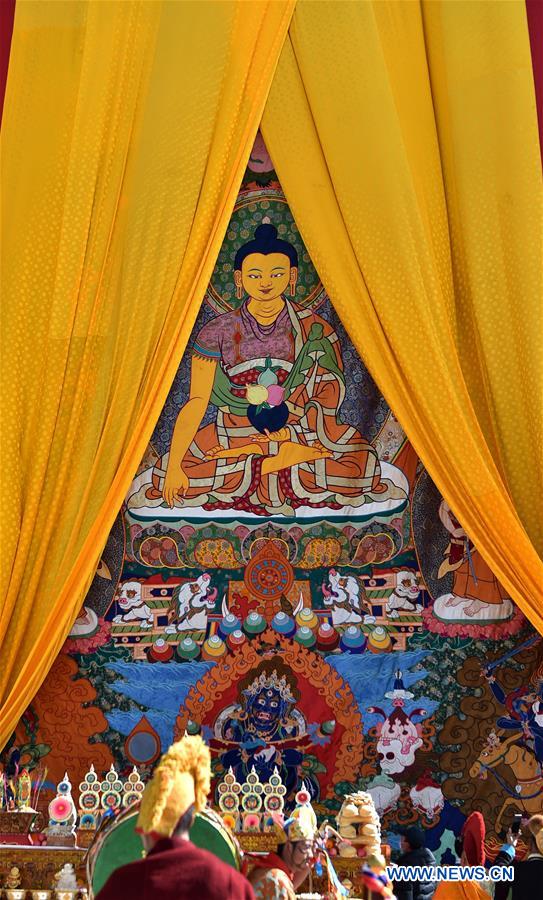
Photo taken on Feb. 19, 2019 shows the site of a Cham dance ritual at the Qoide Monastery in Gonggar County of Shannan Prefecture, southwest China's Tibet Autonomous Region. Dressed in colorful costumes, lamas danced to pounding drums at the Qoide Monastery during the Tibetan New Year celebrations. The Cham dance is a vibrant masked and costumed ritual performed by Tibetan Buddhist monks to exorcise evils and pray for blessings. The Qoide Monastery has a 500-year history of performing the Cham dance. The Cham dance here was listed as one of the national intangible cultural heritages in 2011.
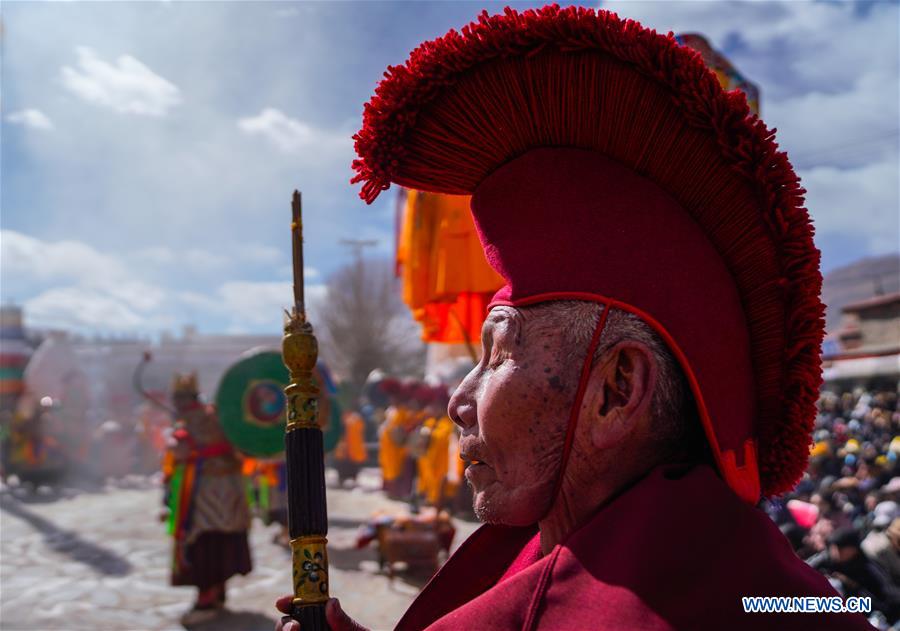
A Tibetan Buddhist monk is seen during a Cham dance ritual at the Qoide Monastery in Gonggar County of Shannan Prefecture, southwest China's Tibet Autonomous Region, Feb. 19, 2019. Dressed in colorful costumes, lamas danced to pounding drums at the Qoide Monastery during the Tibetan New Year celebrations. The Cham dance is a vibrant masked and costumed ritual performed by Tibetan Buddhist monks to exorcise evils and pray for blessings. The Qoide Monastery has a 500-year history of performing the Cham dance. The Cham dance here was listed as one of the national intangible cultural heritages in 2011.

A Tibetan Buddhist monk performs during a Cham dance ritual at the Qoide Monastery in Gonggar County of Shannan Prefecture, southwest China's Tibet Autonomous Region, Feb. 19, 2019. Dressed in colorful costumes, lamas danced to pounding drums at the Qoide Monastery during the Tibetan New Year celebrations. The Cham dance is a vibrant masked and costumed ritual performed by Tibetan Buddhist monks to exorcise evils and pray for blessings. The Qoide Monastery has a 500-year history of performing the Cham dance. The Cham dance here was listed as one of the national intangible cultural heritages in 2011.
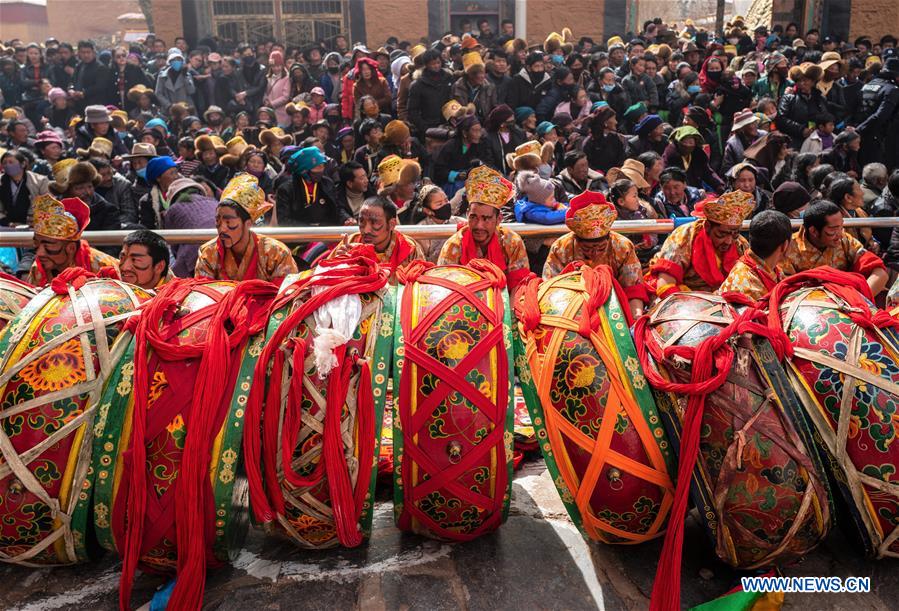
Photo taken on Feb. 19, 2019 shows the site of a Cham dance ritual at the Qoide Monastery in Gonggar County of Shannan Prefecture, southwest China's Tibet Autonomous Region. Dressed in colorful costumes, lamas danced to pounding drums at the Qoide Monastery during the Tibetan New Year celebrations. The Cham dance is a vibrant masked and costumed ritual performed by Tibetan Buddhist monks to exorcise evils and pray for blessings. The Qoide Monastery has a 500-year history of performing the Cham dance. The Cham dance here was listed as one of the national intangible cultural heritages in 2011.
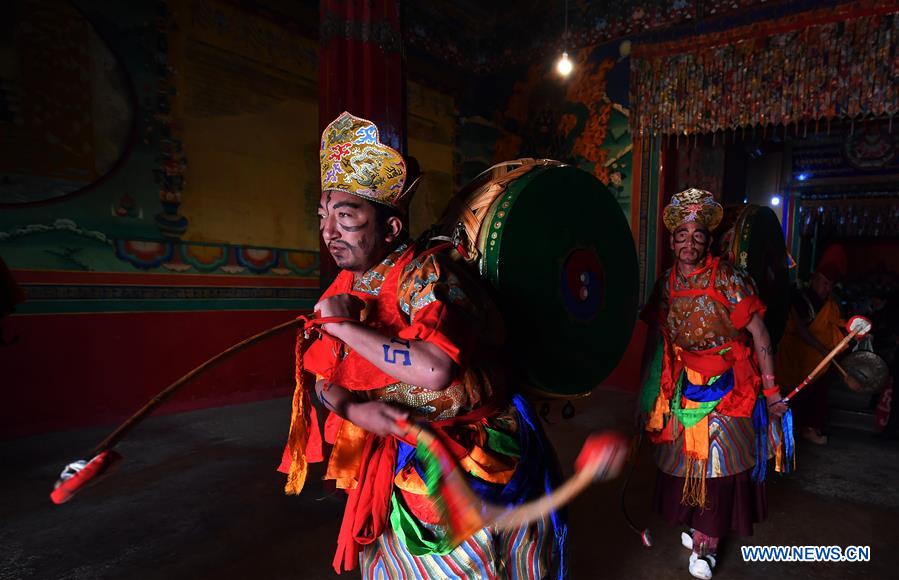
Tibetan Buddhist monks attend a Cham dance ritual at the Qoide Monastery in Gonggar County of Shannan Prefecture, southwest China's Tibet Autonomous Region, Feb. 19, 2019. Dressed in colorful costumes, lamas danced to pounding drums at the Qoide Monastery during the Tibetan New Year celebrations. The Cham dance is a vibrant masked and costumed ritual performed by Tibetan Buddhist monks to exorcise evils and pray for blessings. The Qoide Monastery has a 500-year history of performing the Cham dance. The Cham dance here was listed as one of the national intangible cultural heritages in 2011.

Butter sculptures are displayed during a Cham dance ritual at the Qoide Monastery in Gonggar County of Shannan Prefecture, southwest China's Tibet Autonomous Region, Feb. 19, 2019. Dressed in colorful costumes, lamas danced to pounding drums at the Qoide Monastery during the Tibetan New Year celebrations. The Cham dance is a vibrant masked and costumed ritual performed by Tibetan Buddhist monks to exorcise evils and pray for blessings. The Qoide Monastery has a 500-year history of performing the Cham dance. The Cham dance here was listed as one of the national intangible cultural heritages in 2011.
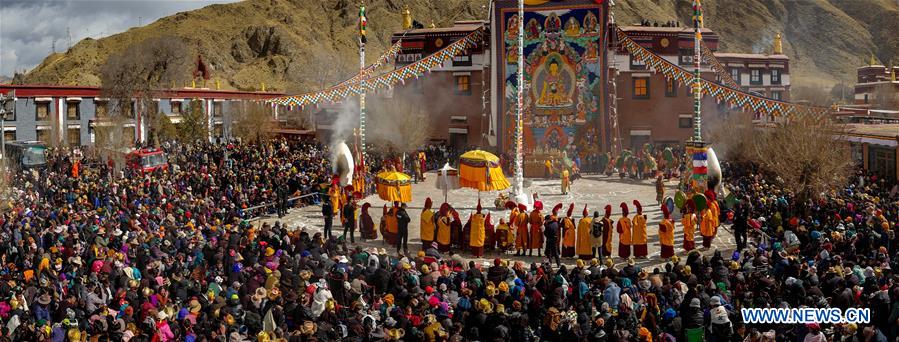
Tibetan Buddhist monks perform during a Cham dance ritual at the Qoide Monastery in Gonggar County of Shannan Prefecture, southwest China's Tibet Autonomous Region, Feb. 19, 2019. Dressed in colorful costumes, lamas danced to pounding drums at the Qoide Monastery during the Tibetan New Year celebrations. The Cham dance is a vibrant masked and costumed ritual performed by Tibetan Buddhist monks to exorcise evils and pray for blessings. The Qoide Monastery has a 500-year history of performing the Cham dance. The Cham dance here was listed as one of the national intangible cultural heritages in 2011.

Tibetan Buddhist monks gets makeup before a Cham dance ritual at the Qoide Monastery in Gonggar County of Shannan Prefecture, southwest China's Tibet Autonomous Region, Feb. 19, 2019. Dressed in colorful costumes, lamas danced to pounding drums at the Qoide Monastery during the Tibetan New Year celebrations. The Cham dance is a vibrant masked and costumed ritual performed by Tibetan Buddhist monks to exorcise evils and pray for blessings. The Qoide Monastery has a 500-year history of performing the Cham dance. The Cham dance here was listed as one of the national intangible cultural heritages in 2011.
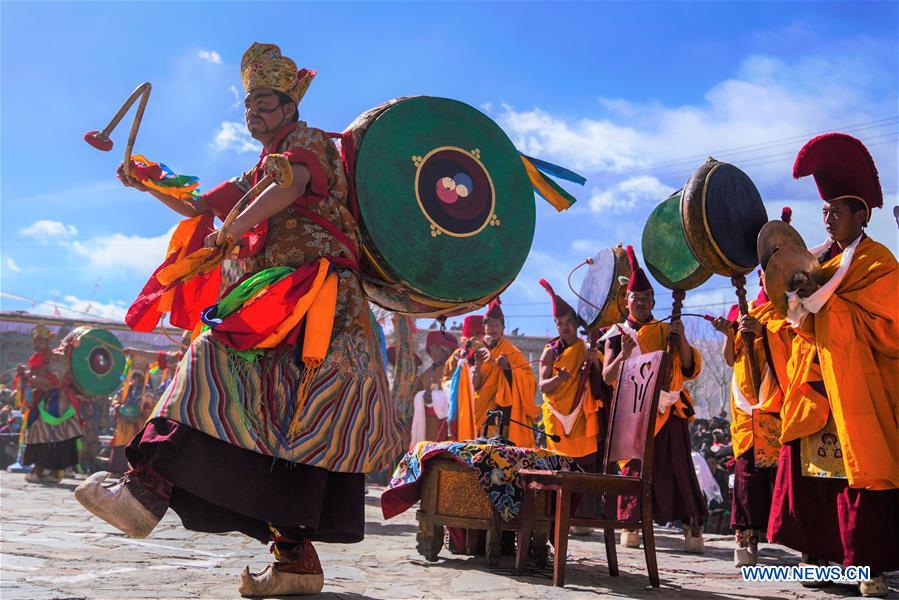
Tibetan Buddhist monks perform during a Cham dance ritual at the Qoide Monastery in Gonggar County of Shannan Prefecture, southwest China's Tibet Autonomous Region, Feb. 19, 2019. Dressed in colorful costumes, lamas danced to pounding drums at the Qoide Monastery during the Tibetan New Year celebrations. The Cham dance is a vibrant masked and costumed ritual performed by Tibetan Buddhist monks to exorcise evils and pray for blessings. The Qoide Monastery has a 500-year history of performing the Cham dance. The Cham dance here was listed as one of the national intangible cultural heritages in 2011.

A Tibetan Buddhist monk performs during a Cham dance ritual at the Qoide Monastery in Gonggar County of Shannan Prefecture, southwest China's Tibet Autonomous Region, Feb. 19, 2019. Dressed in colorful costumes, lamas danced to pounding drums at the Qoide Monastery during the Tibetan New Year celebrations. The Cham dance is a vibrant masked and costumed ritual performed by Tibetan Buddhist monks to exorcise evils and pray for blessings. The Qoide Monastery has a 500-year history of performing the Cham dance. The Cham dance here was listed as one of the national intangible cultural heritages in 2011.
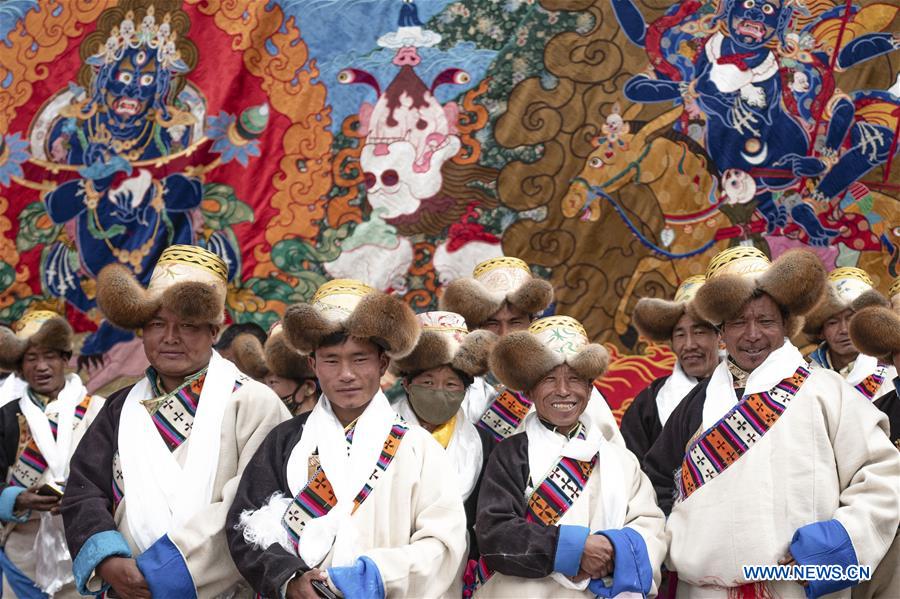
Tibetan Buddhist monks attend a Cham dance ritual at the Qoide Monastery in Gonggar County of Shannan Prefecture, southwest China's Tibet Autonomous Region, Feb. 19, 2019. Dressed in colorful costumes, lamas danced to pounding drums at the Qoide Monastery during the Tibetan New Year celebrations. The Cham dance is a vibrant masked and costumed ritual performed by Tibetan Buddhist monks to exorcise evils and pray for blessings. The Qoide Monastery has a 500-year history of performing the Cham dance. The Cham dance here was listed as one of the national intangible cultural heritages in 2011.
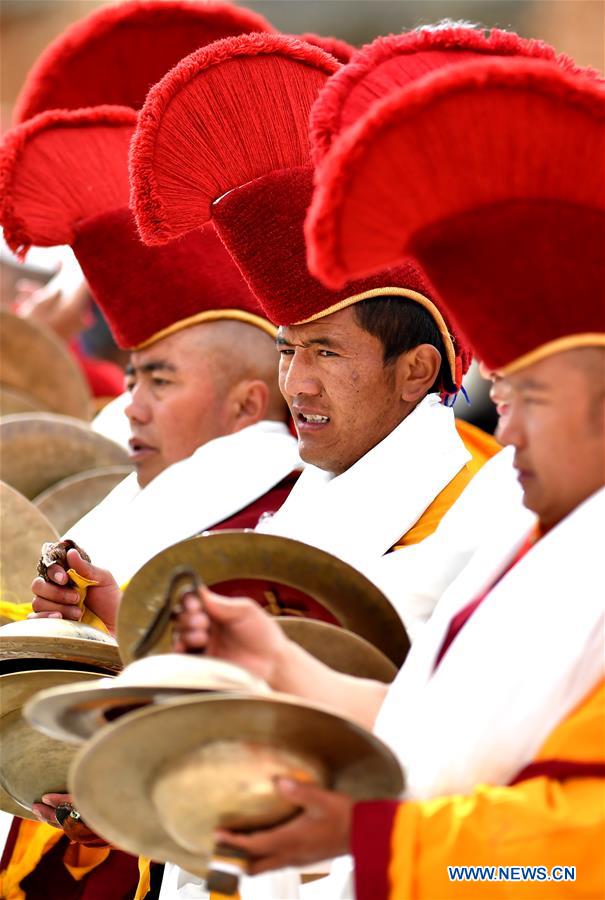
Tibetan Buddhist monks perform during a Cham dance ritual at the Qoide Monastery in Gonggar County of Shannan Prefecture, southwest China's Tibet Autonomous Region, Feb. 19, 2019. Dressed in colorful costumes, lamas danced to pounding drums at the Qoide Monastery during the Tibetan New Year celebrations. The Cham dance is a vibrant masked and costumed ritual performed by Tibetan Buddhist monks to exorcise evils and pray for blessings. The Qoide Monastery has a 500-year history of performing the Cham dance. The Cham dance here was listed as one of the national intangible cultural heritages in 2011.
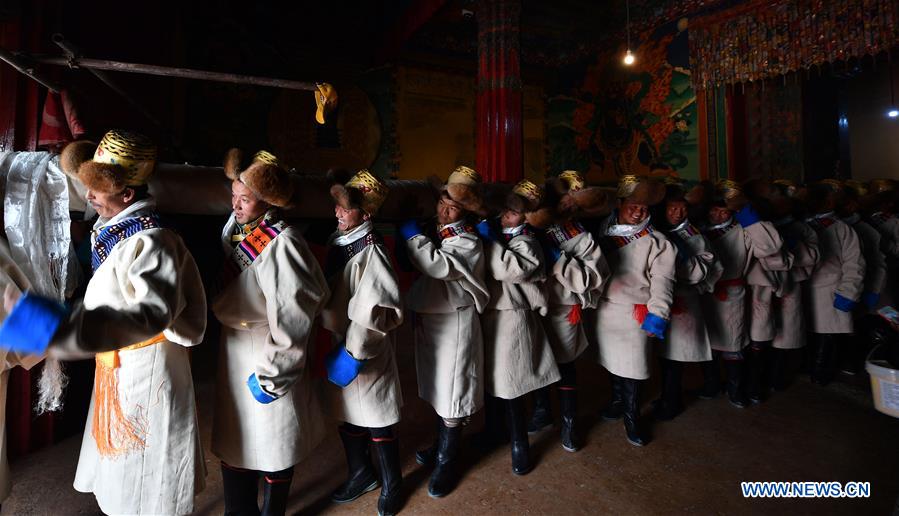
Tibetan Buddhist monks perform during a Cham dance ritual at the Qoide Monastery in Gonggar County of Shannan Prefecture, southwest China's Tibet Autonomous Region, Feb. 19, 2019. Dressed in colorful costumes, lamas danced to pounding drums at the Qoide Monastery during the Tibetan New Year celebrations. The Cham dance is a vibrant masked and costumed ritual performed by Tibetan Buddhist monks to exorcise evils and pray for blessings. The Qoide Monastery has a 500-year history of performing the Cham dance. The Cham dance here was listed as one of the national intangible cultural heritages in 2011.
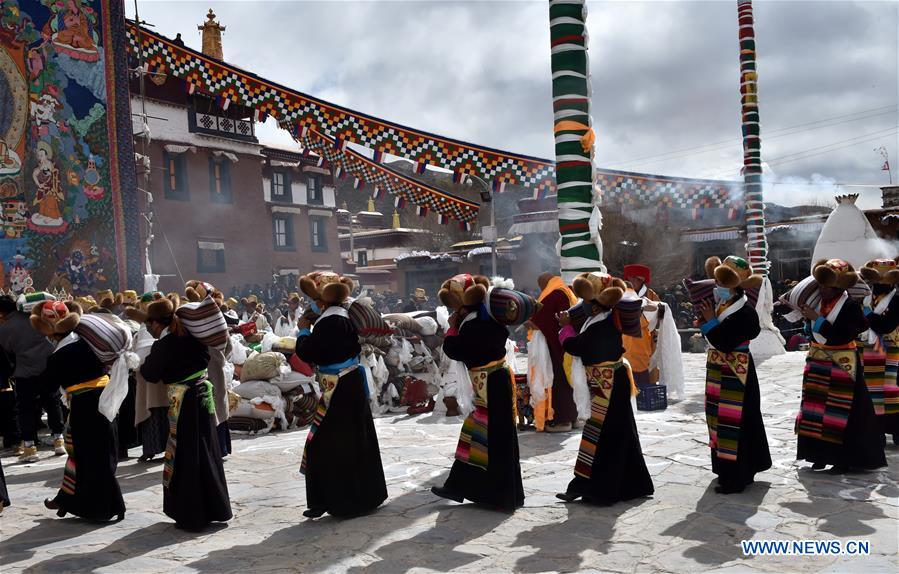
Tibetan Buddhist monks perform during a Cham dance ritual at the Qoide Monastery in Gonggar County of Shannan Prefecture, southwest China's Tibet Autonomous Region, Feb. 19, 2019. Dressed in colorful costumes, lamas danced to pounding drums at the Qoide Monastery during the Tibetan New Year celebrations. The Cham dance is a vibrant masked and costumed ritual performed by Tibetan Buddhist monks to exorcise evils and pray for blessings. The Qoide Monastery has a 500-year history of performing the Cham dance. The Cham dance here was listed as one of the national intangible cultural heritages in 2011.


